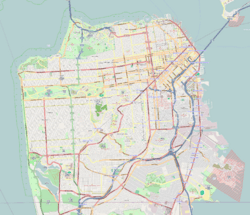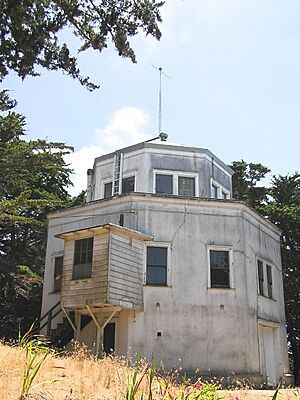Fort Miley Military Reservation facts for kids
Quick facts for kids Fort Miley Military Reservation
|
|
|---|---|
| Near San Francisco, California in United States | |

Ordnance storehouse, the only Fort Miley building from before 1934
|
|
| Coordinates | 37°46′55.72″N 122°30′19.95″W / 37.7821444°N 122.5055417°W |
| Type | coastal defense |
| Area | 54 acres (21.85 ha) |
| Site information | |
| Owner | United States Army |
| Controlled by | United States Army Coast Artillery Corps |
| Site history | |
| Built | 1899 |
| Fate | Decommission 1948 |
| Location | San Francisco, California |
| NRHP reference No. | 80000371 |
| Added to NRHP | May 23, 1980 |
Fort Miley Military Reservation is located in San Francisco, California. It sits on Point Lobos, a headland on the southern side of the Golden Gate. A large part of the site is now part of the Golden Gate National Recreation Area. Other parts, including buildings, were turned into the San Francisco VA Medical Center. This medical center is managed by the United States Department of Veterans Affairs.
Building Fort Miley
In 1885, the U.S. government realized San Francisco Bay needed better protection. William C. Endicott, who was the Secretary of War, led a group called the Board of Fortifications. They said that the coast around San Francisco needed strong defenses.
By 1890, an army engineer named Colonel George Mendel chose a piece of land for a fort. This land was 73 acres near Point Lobos. It belonged to the City of San Francisco and had been a cemetery since 1868. In 1891, the government officially took 54 acres of this land. They paid $75,000 for it. This process is called condemnation, where the government can take private land for public use.
The army didn't do much with the land for a few years. But the Spanish–American War in 1898 changed that. That year, the first two buildings were built. They housed a small group from the United States Army Signal Corps. Their job is not fully known, but they might have watched for enemy ships during the war.
Soon after, construction began on the fort's defenses. In 1899, a large battery was built. It had two huge 12-inch guns. These guns were mounted on special "disappearing carriages." These carriages could hide the guns after they fired, making them harder for enemies to hit. This battery was finished in 1902. A third 12-inch gun was added in 1903. This area became known as Battery James Chester.
At the same time, work started on another battery in 1899. This one was for sixteen 12-inch mortars. Mortars are like cannons that shoot shells high into the air. These weapons could cover all three paths into the Golden Gate. This meant they could protect the bay from any direction.
In 1900, the reservation was renamed Fort Miley. It was named after Lieutenant Colonel John D. Miley. He had died in Manila, Philippines the year before.
To house the soldiers who would operate these guns, the army built a parade ground. They also built many wooden buildings for barracks (where soldiers sleep) and living quarters. Most of these buildings were put up between 1902 and 1906. The parade ground was shaped like a horseshoe. It faced north, giving a clear view of the Golden Gate.
In the early 1930s, Fort Miley's parade ground was chosen for a new hospital. This hospital was for veterans. The army kept the gun batteries. But most of the old buildings around the parade ground were torn down in 1934. Only one building, an ordnance storehouse, was saved.
Fort Miley During World War II
By 1937, the army planned to replace older 12-inch gun batteries like Chester. They wanted to use newer, more modern defenses. However, the Japanese attack on Pearl Harbor in 1941 changed everything. The United States entered World War II. Because of the war, Battery Chester's guns were still very important for coastal defense until 1943.
Later in 1943, the Allied forces started winning battles in the Pacific War. This made the risk of an enemy attack on San Francisco much lower. So, the army decided to remove Battery Chester's guns. They were taken apart and recycled.
A new battery, called Battery 243, was finished at Fort Miley in 1944. This battery was designed for two 6-inch rapid-fire guns. These guns had steel shields instead of thick concrete walls for protection. These types of guns were useful late in the war. They helped protect the submarine minefields outside the Golden Gate. This made it very hard for enemy ships to clear the mines. The guns for Battery 243 were not put in place until 1948. This was after most other coastal guns had been removed. This battery is important because it shows one of the last ideas for coastal defense.
During the war, a group of soldiers called Battery F, 18th Coast Artillery, was stationed at Fort Miley. They were there from November 1941 to April 1944.
Fort Miley Today
The old ordnance storehouse, which survived the 1934 demolition, is still around. It's now used by the National Park Service for maintenance. It's not in its original spot anymore.
There is a walking trail east of the hospital. This trail goes through the area where the storehouse used to be. It has been redone so that wheelchairs and scooters can use it easily. You can still see the remains of several old gun batteries from before World War I around the hospital.
West Fort Miley has a grassy picnic area. It's located among three old gun positions, including Battery Chester. There's also a ropes course on the site. It's run by the Pacific Leadership Institute, which is part of San Francisco State University. This course is in the trees east of the Lands End parking lot.
![]() This article incorporates public domain material from websites or documents of the National Park Service.
This article incorporates public domain material from websites or documents of the National Park Service.







